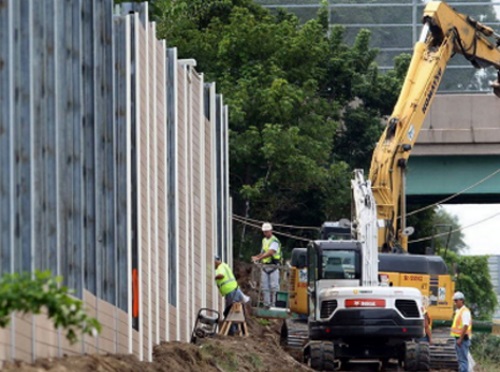FEDERAL ACTION
AASHTO Praises Passage of Historic Transportation Bill – AASHTO
Fact Sheet: The Bipartisan Infrastructure Deal – The White House
EPA tells court it will reconsider air quality standards for ozone – Reuters
FHWA 2022 ENVIRONMENTAL EXCELLENCE AWARDS – FHWA (Request for Nominations)
COVID-19
Pandemic milestone: U.S. ends international travel ban, opening the door to vaccinated tourists – CNBC
INFRASTRUCTURE RESILIENCE AND SUSTAINABILITY
AASHTO’s Tymon Talks Infrastructure on C-Span – AASHTO Journal
Public transportation can save the world – if we let it – The Verge
The battle over a vast New York park: is this climate resilience or capitalism? – The Guardian
Kansas City hopes its vision for airport solar will be ready for takeoff soon – Energy News Network
Industry still behind in race for enough truck parking spaces – FleetOwner
AIR QUALITY
Pennsylvania Governor Awards $9.5 Million to Reduce Pollutants and Increase Clean Transportation – Pennsylvania Governor’s Office
Port of Seattle Sets 2040 Net Zero Emissions Target – Ship & Bunker
ENVIRONMENTAL JUSTICE
AASHTO President: Embrace the “New Normal” of Equity – AASHTO Journal
Biden wants to ‘reconnect communities’ cut off by interstates – this infamous Baltimore highway shows what’s at stake – MarketWatch
PA Governor Wolf Establishes PA Office of Environmental Justice – WKOK Radio
The event that changed the environmental justice movement forever – Grist
Delays frustrate White House environmental justice advisers – E&E News
NATURAL RESOURCES
California desert high-speed rail line could block sheep, mountain lions. Democrats want more crossings. – Merced Sun-Star
How Minneapolis’ simple change to newly constructed boulevards will improve water quality – MinnPost
Hundreds of SCDOT employees participating in “Grab a Bag SC” litter pickup Tuesday – WOLO-TV
NCDOT Wildflower Program among the most recognized in the country – WGHP-TV
ARDOT Rolls Out Anti-Litter Campaign With Keep It Clean, Arkansas Video – Arkansas DOT (Media release)
CULTURAL RESOURCES
Wisconsin DOT Unveils Dual Language Signs – WJFW-TV
Seattle-Tacoma International Airport is setting new standards for public art – The Points Guy
HEALTH AND HUMAN ENVIRONMENT/ACTIVE TRANSPORTATION
New and expanded trail system in north Shelby County, Alabama – Bham Now
Online Survey To Gather Comments on Hawaii Bikeway Needs – Hawaii DOT (Media release)
TRB RESOURCES/ANNOUNCEMENTS
COP26 Presents Historic Opportunity for a More Sustainable Future, Say Presidents of U.S. National Academies – National Academies of Sciences, Engineering, and Medicine
Transit and Micromobility – TRB
TRB Webinar: Creature Comforts – Designing Terminal Restrooms and Ancillary Spaces – TRB
FEDERAL REGISTER NOTICES
Surface Transportation Project Delivery Program; Arizona Department of Transportation Final FHWA Audit Report – FHWA (Notice)
Notice of Intent To Prepare a Draft Environmental Impact Statement for the Last Chance Grade Permanent Restoration Project on Interstate 101, in Del Norte County, California – FHWA (Notice)
National Wetland Plant List – Army Corps of Engineers (Notice)
Board of Scientific Counselors (BOSC) Safe and Sustainable Water Resources Subcommittee Meeting – December 2021 – EPA (Notice of public meeting)
Announcement of the Board of Directors for the National Environmental Education Foundation – EPA (Notice of appointment and re-appointment; correction)
Deadline Extension for Regional Roundtable Discussions Regarding ‘‘Waters of the United States’’ – Corps of Engineers and EPA (Notice of events; extension of deadline request for nominations)
Coastal Nonpoint Pollution Control Program: Proposal To Find That Ohio Has Satisfied Conditions on Earlier Approval – NOAA and EPA (Notice of proposed finding; request for comments)
Hazardous Materials: Suspension of HMR Amendments Authorizing Transportation of Liquefied Natural Gas by Rail – Pipeline and Hazardous Materials Safety Administration (Notice of proposed rulemaking)
Notice of Competitive Offer for Solar Energy Development on Public Lands in the State of Arizona – Bureau of Land Management (Notice)
Amended Order Implementing Presidential Proclamation on Advancing the Safe Resumption of Global Travel During the COVID–19 Pandemic – CDC (Notice)
Requirement for Negative Pre- Departure COVID–19 Test Result or Documentation of Recovery From COVID–19 for All Airline or Other Aircraft Passengers Arriving Into the United States From Any Foreign Country – CDC (Notice of agency amended order)
Requirement for Airlines and Operators To Collect and Transmit Designated Information for Passengers and Crew Arriving Into the United States; Requirement for Passengers To Provide Designated Information – CDC (Notice of agency order)


